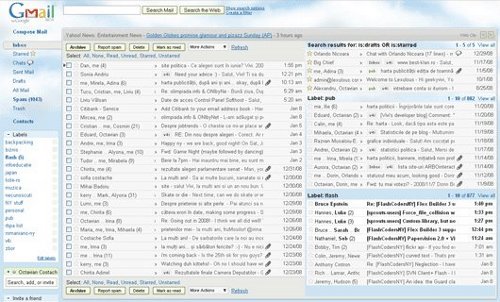Interestingly, out of Gmail, Yahoo Mail! and Hotmail, only the first one does not append advertising messages to actual emails. I am rather surprised by this, given we just started with the year 2008.
I remember back when Hotmail and other webmail services were just starting, it was a common practice to monetize on advertising banners shown to webmail users, while also embedding advertising messages into outgoing emails. That was a really ugly situation, but a lot of people suddenly got free access to email, which was great, so we lived with it.
While free webmail has always been useful, most web people prefer to have a mailbox under their own domain. Or at least they preferred before Gmail came into play.  Nobody ever took you very serious if you were communicating using a well known free webmail service.
When the coolness of your own domain started to grow, many webmail services tried to meet the needs of their users and attempted to hide the obvious facts of them being free webmail services. This was the time when webmail services registered tonnes and tonnes of domain names and offered their users a choice of any for their mailbox. It was also the time when some stopped embedding advertising into outgoing emails.
For a few years, I stopped caring much about this issue, since I got a proper mailbox, as did many other people with who I communicated. I knew of webmail existence, but it was mostly outside of my scope of interests.  Until Gmail came out.
With Gmail, Google changed the perception of webmail once again. Two things that they did differently were AJAX interfaces, which provided for a much faster and more responsive user experience, than traditional web sites; and plenty of space. If I remember correctly, Gmail offered something like 1 GB mailboxes. That was in time when most other webmail services were giving out 10 or 15 MB. “You will never have to delete an email message ever again“.
Google managed to make webmail popular again.  They implemented most of the good stuff, ignored mistakes, and came up with a few smart things of their own (conversation grouping, labels instead of folders, etc). And, of course, one of the things that they did right was the advertising. While reading mail, users see ads for related stuff – in clean, text, no blinking manner. And no outgoing message is ever modified by Gmail to include advertising or to suggest that recipient should give Gmail a try, or any of such nonsense.
I move all my mailboxes to Gmail. This my only email interface these days. And I’m pretty used to it now. And a lot of other people are back to webmail. And so it amazes me to no avail that some web services still don’t get it. After all this time and all these lessons. They still including their ads in outgoing messages. This is really weird…
To all of you using Yahoo Mail, Hotmail, et al, – you should really give Gmail a try. At least you’ll know for sure that your recipients will get messages exactly as you send them. No more, no less.


